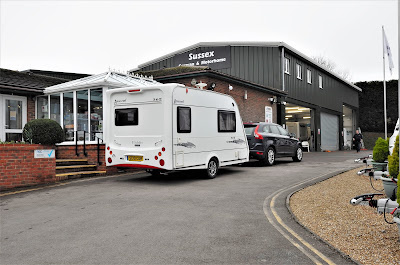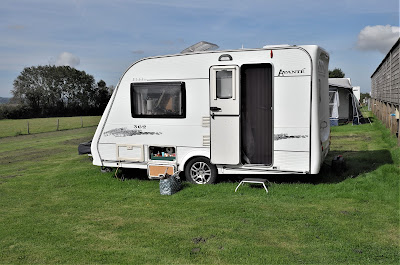Here's my beloved caravan at the the Sussex Caravan and Motorhome Centre at Ashington, north of Worthing. I'd just towed it there for its annual service, after emptying out. This was on 16th February. I expected to have new tyres, but otherwise get away with only the usual checks and attentions. Let's say a £600 bill.
I have a long association with this dealership, and I am a well-known customer. They may have only sold me one caravan, but the annual maintenance work, plus occasional big repair and replacement jobs, have given them good business.
I bought my caravan there in November 2006, and have had it serviced annually by them ever since. Usually I get away with routine checks on structure, running gear, and the gas, electricity and water systems - a comprehensive 'MOT' in fact.
But caravans are essentially lightweight cabins on wheels, and the shaking and bumping they get when towed gradually loosens them up. In any case tyres become too old to be legal, and, bit by bit, various things wear out. My caravan will be sixteen years old by the end of this year, and is in remarkably good condition, considering all the use it gets each year, and how far I tow it in my travels.
But it isn't immortal. At some stage I will have to write it off. That time hasn't come yet, but it will. Then I will have to consider giving up caravanning - a source of 'cheap-as-chips' holidays, if you own one - or invest in a replacement. A caravan can be towed by a conventional diesel car, or an electric one, so if I did get something else, it wouldn't be waste of money, so long as I wanted to holiday in a caravan (which I would always want to) and have a car capable of towing it (I'm sure I always would).
Currently a new caravan like mine - if I were forced to buy one - would cost me about £20,000 or so. A good used one, six or seven years old, £10,000. So I measure the cost of any repairs that crop up against these figures. As the title of this post suggests, I am now looking at spending £3,500. That's £715 for the service itself (all the tyres had to be replaced, the spare included; and, unexpectedly, a wheel bearing), and some £2,800 for extensive damp-proofing work, mostly labour.
It's a no-brainer. £3,500 is the final nail in the coffin so far as my 2022 savings plans are concerned, but much the lesser outlay compared with getting a new (or newer) caravan. So I've said yes. I should have my caravan back early next week, and then I'll be ready for the year's holidays: 99 nights away. Well, I do want to get my money's worth!
So what is that £2,800 on damp-proofing for?
Basically rain-water and dew have been getting in behind aluminium rails and similar metal strips all over the caravan exterior. These metal strips, such as the long awning rails, are fixed to the aluminium roof and sides with screws, and sealed with mastic. The awning rails are the long strips you can see in this shot of the caravan down in Devon last year:
The nearside awning rail runs from the front corner, at floor level, then all the way upwards and along, finally curving downwards towards the back corner. On the other side of the caravan is a similar aluminium strip. If a section of rail works loose - and they get a battering from twigs and branches on narrow country lanes - the sealing is exposed and, if it is old, water may get in and seep inside. The top section of the awning rail covers the important junction of roof and side wall. It's especially important that no water gets in anywhere along there.
But every hatch - and the entrance doorway itself - is a potential location for water ingress as seals degenerate with time. That side-hatch in the photo just above is where I stow tins and other bulk goods after a visit to the local supermarket. Here's a close-up:
It's a cool and shady place - good for potatoes and fruit, as well as tins and kitchen rolls. But you can clearly see the potential for water getting in, if that hatch door develops a leaky spot.
Well, although nothing can be seen inside the caravan, damp is getting in. I spent twenty minutes in the workshop with Owen, the service manager, as he showed me with his electronic damp detector exactly where the moisture readings were high. There was a pattern to the damp ingress: it was mostly along the metal rails running the length of the caravan, and concentrated in the bottom corners. The floor at each nearside corner was actually a little damp to the touch. At the moment it would - given fine weather - all dry out, as will no doubt happen this summer if it's a hot one. But prolonged exposure to rain will only make the dampness worse. And once damp takes hold, and mould begins, a caravan is doomed.
Bottom line: they could treat just the individual high-reading spots, and charge me less. But Owen recommended continuous treatment front to rear, a full job, if I wanted the caravan to be waterproof for years ahead.
I asked him whether they was anything about my caravan - something mechanical or electrical say - that would stop it functioning at some point and make spending £2,800 on damp-proofing a waste of good money. There wasn't. In which case, it was worth doing. Extensive dismantling had already taken place, so they could get on with the work at once. Three or four days.
So there matters stand. I'm philosophical. At some point, those seals would fail. It's a pity that they have done so this year, when I've already spent a small fortune on my car, and will have to meet the cost of a new boiler this summer. But once all that stuff is out of the way, I'm good for a long time ahead.
The new costs don't impinge on my holiday budget. That's ring-fenced. I will just look to get the very most from my 99 nights away. The Grand Tour of Scotland included. My goodness, I shall savour every moment!



